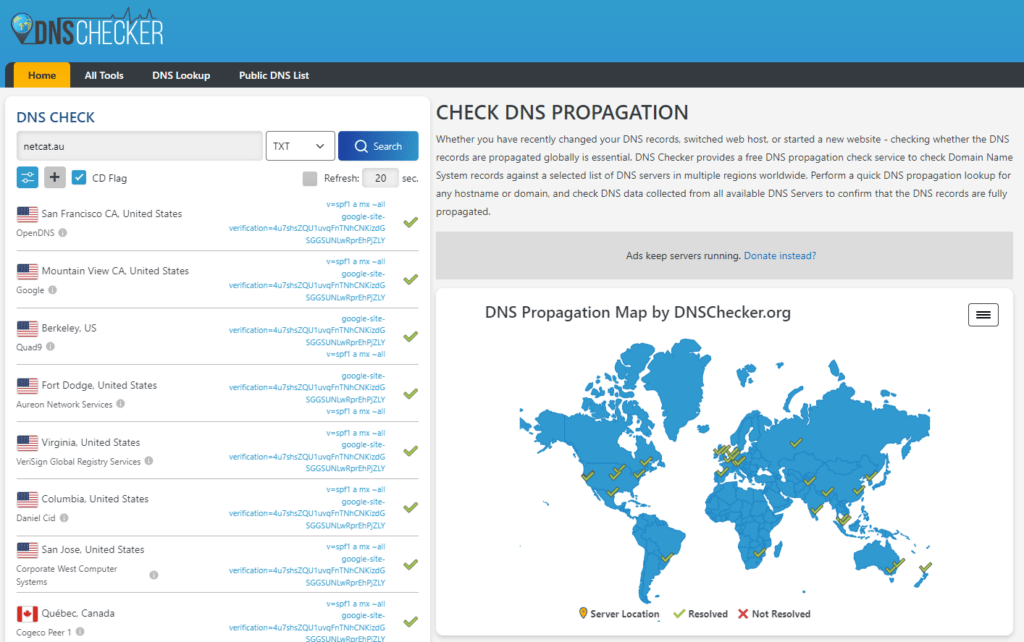DNS Propagation refers to the time delay between when a DNS record is updated and when DNS servers worldwide refresh their caches to return the most up-to-date record. This process can take anywhere from a few seconds to over 48 hours, depending on several factors.
Understanding DNS Propagation
When you update a DNS record, the changes don’t instantly reflect across all DNS servers globally. This delay, known as DNS propagation, can be frustrating—especially if your website is down or emails are misrouted.

Factors Affecting DNS Propagation Time:
- Local Cache: If a computer or device has recently accessed the domain, it may still use the old DNS record from its local cache.
- DNS Server Cache: The DNS servers used by your device may have cached the record, further delaying the update.
- TTL (Time to Live): This value, set on the DNS record, determines how long the record can be cached before a new query is required. TTL values typically range from 60 seconds to 86,400 seconds (24 hours).
Why DNS Records Are Cached: DNS records are cached in various locations to enhance site performance and reduce server load. Since DNS records don’t change frequently, caching them helps avoid unnecessary DNS queries for every website action, which would otherwise slow down browsing.
How DNS Propagation Works: When a device performs a DNS lookup, it first checks its local cache. If not found, it may then check the cache on the router or the ISP’s DNS servers. The TTL value determines how long a record can be cached before it must be refreshed. Since DNS is a “pull” system, the device’s DNS server must request the latest records from the authoritative name servers where the DNS records are originally set.
Unfortunately, there is no reliable way for web hosts or service providers to force a DNS cache refresh. The best solution is often to simply wait, as the updated records will typically propagate across the internet within 48 hours.
Check DNS Propagation Status: To verify that your DNS records are correctly set and have propagated globally, you can use a tool like DNS Checker.
Speeding Up DNS Propagation
While DNS propagation can be a waiting game, there are some proactive steps you can take to help speed up the process:
1. Lower the TTL Value in Advance:
About 24 hours before changing the DNS record, set the TTL (Time to Live) value down to 300 seconds (5 minutes). This reduces the time that third-party name servers and end devices will cache the old DNS records, ensuring they check for the updated records more frequently.

2. Force Major DNS Providers to Flush Their Caches:
After updating the DNS record, you can manually flush the DNS caches of major DNS providers. This increases the likelihood that your website visitors will see the new DNS record sooner. Use the following links:

3. Restart Devices and Networking Equipment:
If you or someone else is still having trouble seeing the updated site, try restarting the computer and rebooting the router or modem. This can help clear local DNS caches.

4. Test on a Mobile Device Using Cellular Data:
Mobile devices on 4G or 5G networks tend to update DNS records faster than wired connections, making it a good way to check if the new DNS record has propagated.

5. Verify DNS Changes with Your Provider:
DNS changes should be reflected almost instantly at the DNS provider level. If you don’t see the new DNS changes after updating, contact your DNS provider to ensure the changes have been properly applied. Common reasons for DNS records not propagating include issues with the web interface not syncing to your providers authoritative name servers or a DNSSEC issue (such as changing name servers without update the DNSSEC records) preventing other DNS Servers acknowledging the changes.

By following these steps, you can minimize the waiting time for DNS propagation and ensure that your updates are reflected as quickly as possible across the internet.
Do you use any different strategies for handling DNS Propagation or been caught out waiting? Let us know in the comments below